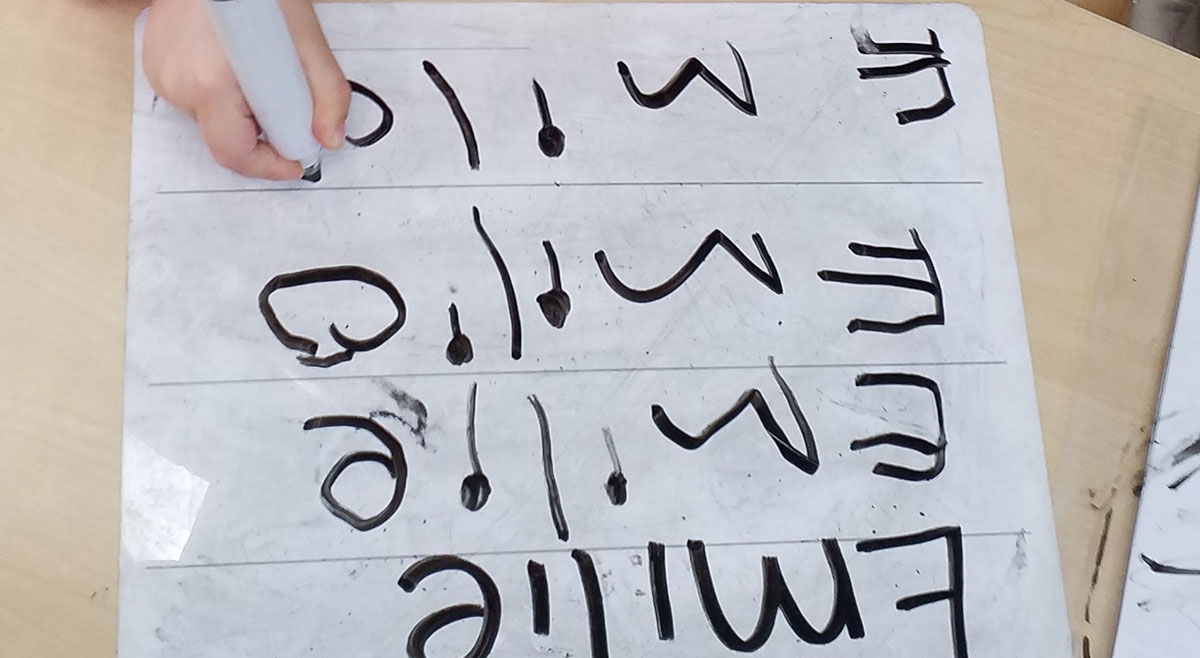Early writing at Willow Preschool is the fundamental skill that children need to develop before they are able to write. They are the ways that children give meanings to the markings they create, it helps develop their understanding of how written language works and focuses on how children’s marks reflect growing understandings of the writing system. These skills contribute to the child’s ability to hold and use a pencil, and the ability to draw, write, copy, and colour. Children learn that you can communicate through writing and that marks have meaning, by watching you write. You could write labels in front of them, while you explain, the direction of the print, or what the word is. We use these labels for everyday objects the children are interested in. For example, cars, chairs, tables, toy boxes, etc. When supporting transcription, we give children opportunities to develop finger strength. In the early stages, children need lots of fun and play activities. Provide lots of activities to work at a large-scale using brushes on walls outside, before they move on to using chunky crayons or pencils. For example, to develop finger strength in preparation for writing, show them activities like manipulating dough, completing puzzles, or threading blocks onto a rope.
Fine motor skills are one of the fundamental skills that improve early years writing as they are finger and hand skills, such as writing, cutting, opening lunch boxes, and tying shoelaces. The development of these skills relies upon the age-appropriate development of physical skills (such as core trunk control and shoulder strength) providing a stable base from which the arm and hand can then move with control. We help children develop fine motor skills to grasp, hold, and strengthen fingers and thumbs by scrunching paper and using pick-up tools. For example, use big tweezers to pick up plastic shapes. This is essential for the child to be able to develop the ability to hold and move a pencil fluently and effectively and therefore produce legible writing. When these skills are underdeveloped, it can lead to frustration and resistance due to the child not being able to produce legible writing or to ‘keep up’ in class due to fatigue. A major component of early writing skills is the shapes that children make. These are the pencil strokes that most letters, numbers, and early drawings are comprised of. They are typically mastered in sequential order and to an age-specific level.
Practitioners give children opportunities to develop core strength and ‘muscle isolation’, a crucial first step towards writing. Activities like reaching across the body to put on socks and shoes help children to use their right or left, body side without the other side moving at the same time. Also, encourage activities like climbing, throwing, and catching. Children move through development stages in their mark-making and gradually muscle control becomes more defined until they develop an ability to use straight lines and curves to form symbols.
Babies
Generally, 0- to 2-year-olds enjoy sensory activities, establishing a fun and fascination with shapes, marks, letters, and numbers. For example, hide letters and shapes in foamy water. Share books, repeating words, phrases, and rhymes. Play finger games like ‘Incey Wincy Spider’. Concentrate on activities that could lead to writing, like making marks with large toys, or with fingers in wet sand.
Toddlers
Generally, 2- to 3-year-olds like retelling their favorite stories and events. Capture these by drawing lines, dots, and circles. Promote physical development, communication, and understanding. If children use a particular dominant hand, encourage them. This age group should learn ‘mark-making’.
Preschool
Generally, 3- to 4-year-olds start behaving like writers, making wavy lines and distinct separate marks. If children show an interest and want to write, it is crucial that they should develop hand and finger strength to hold a chunky crayon or pencil comfortably and with control. Eventually, they may be able to make attempts to write some very familiar letters, for example from their name.
Preschool children are not expected to achieve conventional spelling patterns, it is the attempt that counts and the realisation that marks have meaning. If children show an interest in writing letters, we support them to be ready for the next stage of their learning by encouraging them to hold a pencil correctly and form the letter starting in the right place and moving in the right direction as this will support them to develop good habits for the future. Supporting children’s composition by reading stories, talking to children, re-phrasing what they have said, and modeling correct sentence structure. This will support children to share their ideas and help them to develop an understanding of how sentences are formed. Engaging the children in a variety of activities, that develop their communication and language, and literacy, can help to extend a child’s vocabulary, and give them words as they begin to form sentences.
Here at Willow Preschool, we provide many opportunities for children to capture their thinking and structure it for a range of purposes and audiences. For example, recording names of characters in their favorite picture books; making invitations to members of their family for party shows or local events. Role-playing and engaging their imaginative play about everyday experiences provide opportunities to write too, for example, in an office using a keyboard, answering a toy phone, and making notes for Mummy or Daddy or if they go to the shops they may ‘write’ shopping lists for what they need to buy.



